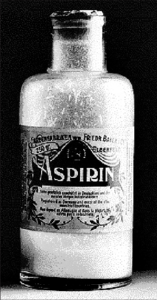
 Who hasn’t heard of Bayer Aspirin, or at the very least, aspirin? It has been a staple in households for as many as 124 years…until the Tylenol push, which in my opinion is the least effective pain medication of all time!!! Aspirin was developed from acetylsalicylic acid, which can be found in the bark of willow trees. Of course, it didn’t originate there. In its most primitive form, the active ingredient, Salicin was used for centuries in folk medicine, beginning in ancient Greece when Hippocrates used it to relieve pain and fever. I guess “modern medicine” hasn’t progressed so far after all. The Bayer version of aspirin was developed in Germany and patented on March 6, 1899. Even then, its unpleasant taste and tendency to damage the stomach, caused its sparing use. In the most modern adaptation of aspirin, the Bayer version, Bayer employee Felix Hoffmann found a way to create a stable form of the drug that was easier and more pleasant to take. Some evidence shows that Hoffmann’s work was really done by a Jewish chemist, Arthur Eichengrun, whose contributions were covered up during the Nazi era. After obtaining the patent rights, Bayer began distributing aspirin in powder form to physicians to give to their patients one gram at a time. The brand name came from “A” for acetyl, “spir” from the spirea plant, which was a source of salicin, and the suffix “in,” commonly used for medications. It quickly became the number-one drug worldwide.
Who hasn’t heard of Bayer Aspirin, or at the very least, aspirin? It has been a staple in households for as many as 124 years…until the Tylenol push, which in my opinion is the least effective pain medication of all time!!! Aspirin was developed from acetylsalicylic acid, which can be found in the bark of willow trees. Of course, it didn’t originate there. In its most primitive form, the active ingredient, Salicin was used for centuries in folk medicine, beginning in ancient Greece when Hippocrates used it to relieve pain and fever. I guess “modern medicine” hasn’t progressed so far after all. The Bayer version of aspirin was developed in Germany and patented on March 6, 1899. Even then, its unpleasant taste and tendency to damage the stomach, caused its sparing use. In the most modern adaptation of aspirin, the Bayer version, Bayer employee Felix Hoffmann found a way to create a stable form of the drug that was easier and more pleasant to take. Some evidence shows that Hoffmann’s work was really done by a Jewish chemist, Arthur Eichengrun, whose contributions were covered up during the Nazi era. After obtaining the patent rights, Bayer began distributing aspirin in powder form to physicians to give to their patients one gram at a time. The brand name came from “A” for acetyl, “spir” from the spirea plant, which was a source of salicin, and the suffix “in,” commonly used for medications. It quickly became the number-one drug worldwide.
In the beginning, like most drugs, Aspirin was a prescription-only drug, but in 1915, Aspirin was made available in tablet form and without a prescription. In 1917, when Bayer’s patent expired during the First World War, the Bayer company lost the trademark rights to aspirin in various countries. After the United States entered the war against Germany in April 1917, the Alien Property Custodian, a government agency that administers foreign property, seized Bayer’s US assets. Two years later, the Bayer company name and trademarks for the United States and Canada were auctioned off and purchased by Sterling Products Company, later Sterling Winthrop, for $5.3 million. 

As companies do, with mergers and splits, Bayer became part of IG Farben, the conglomerate of German chemical industries that formed the financial heart of the Nazi regime. Then after the Nazi defeat in World War II, the Allies split apart IG Farben, and Bayer again emerged as an individual company. With its purchase of Miles Laboratories in 1978, came a product line including Alka-Seltzer and Flintstones and One-A-Day Vitamins. Then in 1994, coming full circle, Bayer bought Sterling Winthrop’s over-the-counter business, which allowed it to gain back the rights to the Bayer name and logo, and after almost 100 years, and the company once again was allowed to profit from American sales of its most famous product.


Leave a Reply